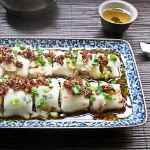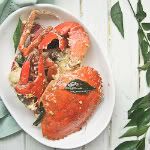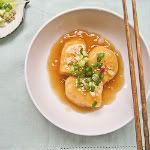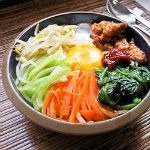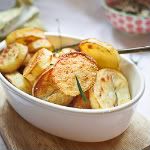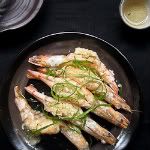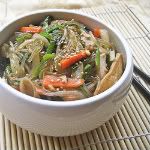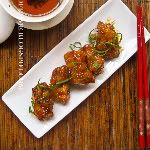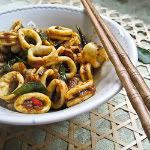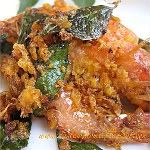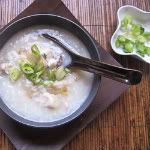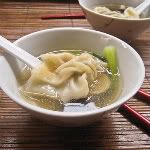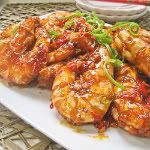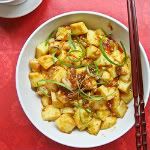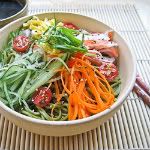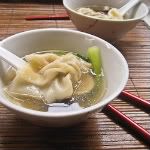Tuesday, November 30, 2010 |
Labels:
Asian Snacks,
Korean Recipes,
Spicy
|
20 Comments »
I am so excited today to present apparently the Korean street food from my humble kitchen - ddukbokki (떡볶이) or Korean spicy rice cakes. An extremely comforting yet easy to make snack, ddukbokki are usually cooked with cylindrical rice cakes or dduk (made of glutinous rice flour usually and then steamed) stir-fried in a spicy gochujang (Korean red pepper paste) based sauce. These rice cakes are very dense and produce an extremely filling dish. When I saw these snacks in many a popular Korean dramas I was guiltily addicted to a few years ago, I got curious - the red gooey rice cakes looked intriguing and so appetizing to me. It was only recently though that I got curious enough to make these for myself (armed with some tips from my Korean friend), I now totally understand why ddukbokki is so popular - warm, chewy rice cakes coated in a yummy spicy and sweet sauce - totally addictive!
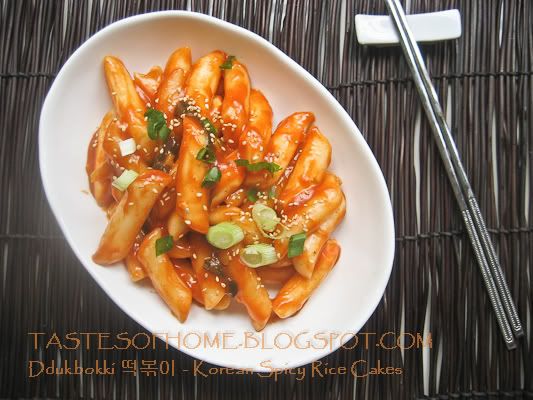
According to my Korean friend, there are a million ways to make ddukbokki and every Korean household probably has different ways of making it. (There also seems to be a million ways of romanizing this snack i.e. tteokbokki, dduk bok kie, tuck boy key and the list goes on). I prefer mine spicy and sweet so I used gochujang, sugar and a bit of ketchup for an additional punch. These cute rice cakes are usually sold at the street stalls in Korea stir-fried with a variety of ingredients including fish cakes, a myriad of vegetables, bulgogi and even cheese or with ramen. One can also add eggs to the dish - usually hard boiled. I just went the bare route today, my ddukbokki consist of only rice cakes, green onions, garlic and of course a healthy sprinkling of toasted sesame seeds as the finishing touch.

Next time, I shall try pan-frying the rice cakes in soy rather like how us Chinese like to cook radish cakes with beansprouts and chives.

Sunday, November 28, 2010 |
Labels:
Asian Soups,
Seafood Recipes,
Spicy,
Thai
|
9 Comments »
Growing up in Malaysia, I have always been a huge fan of the culinary offerings from our northern neighbour, Thailand. I was just thinking to myself last week as to why it took me this long to actually cook something Thai - so I thought I would start with something so uniquely Thai yet is also probably one of its' most famous dishes, the tom yum soup. Loosely speaking, I guess tom yum soup can be described as a version of a bouillabaise, the traditional Provencal fish stew. I love the use of aromatic herbs in Thai cooking and of course I am naturally drawn to the irresistible spicy flavours of most Thai dishes.
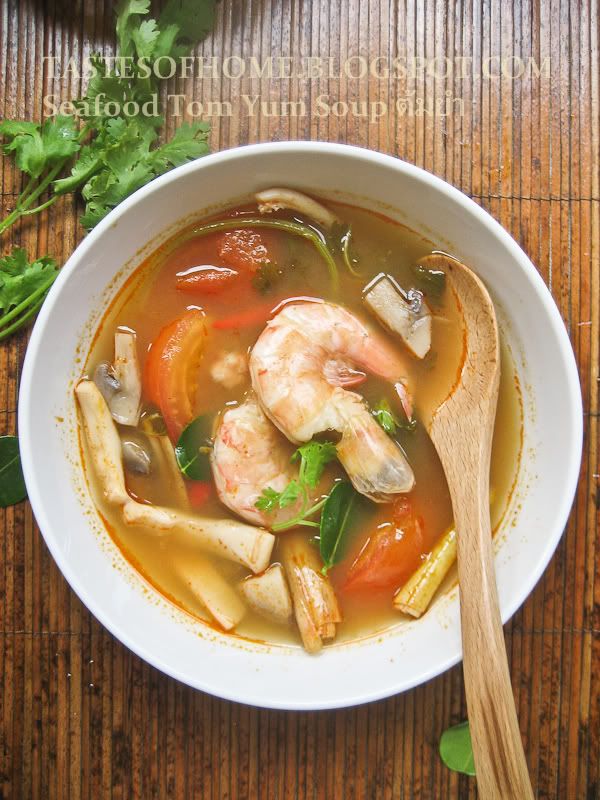
After some digging around, it seems that nam prik pao or Thai roasted chilli paste is a must in tom yum soups. The spicy paste is made mainly out of chilli peppers and shrimp paste which imparts precious flavour to the soup. The chilli paste is also often served as a condiment at the dining table with vegetables.

The lemon grass and kaffir lime leaves are must-haves in the soup, I think I could possibly skip galangal but definitely not the lemon grass or lime leaves.
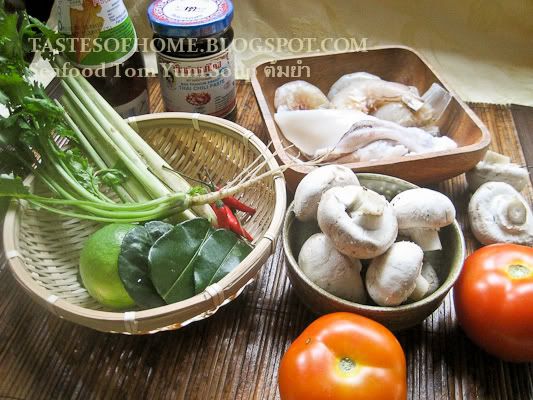

Thursday, November 25, 2010 |
Labels:
Baking,
bread,
Snacks,
Tea-time,
teatime
|
18 Comments »
This is the very first time I am featuring bread here - I have tried baking bread at home just a handful of times so far but I have never been really satisfied with the results. Now finally I've found an excellent recipe for making soft and fluffy bread at home. This is thanks to Christine of Christine's Recipes' wonderful bread recipes. I think I have vaguely heard of the 'tangzhong' (湯種) method (water roux) for baking bread which is a flour paste starter that ensure soft, fluffy bread that will stay soft for days - but I only started to be really interested after seeing so many of Christine's wonderful bread creations on her blog, especially her bacon and cheese bread recipe.

I did this the hard way though that is I kneaded the dough by hand, the dough with this method is stickier than most other bread doughs and I tried my best to not add too much additional flour while kneading and just stuck with the stickiness. Luckily for me, the bread still turned out soft, fluffy and delicious. There are endless possibilities for this bread recipe, pick any filling of your choice or just leave it plain for yummy toast. Today I just experimented with a very simple filling, sugared raisins with dabs of butter.
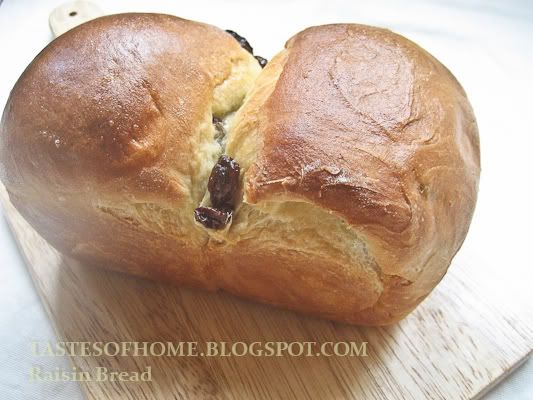

Monday, November 22, 2010 |
Labels:
chicken,
Chinese food,
Chinese recipes,
Poultry recipes,
Spicy
|
22 Comments »
Kung Pao Chicken or 宫保鸡丁is almost inarguably one of the most famous Chinese dishes, the fiery yet delicate flavours and the contrasting textures of the crunchy nuts mingling with the tender chicken cubes make the dish irresistible. As with many Chinese dishes, there are so many versions floating around and after some research, I concluded that an authentic kung pao chicken is supposed to taste a little sweet, a little spicy and a little sour - hence the addition of a tiny bit of black vinegar. In addition, I have always been curious as to why this dish is named 宫保鸡丁, 鸡丁 just means tiny chicken cubes but what about 宫保 which really has nothing much to do with the food or the ingredients in this richly flavoured dish?
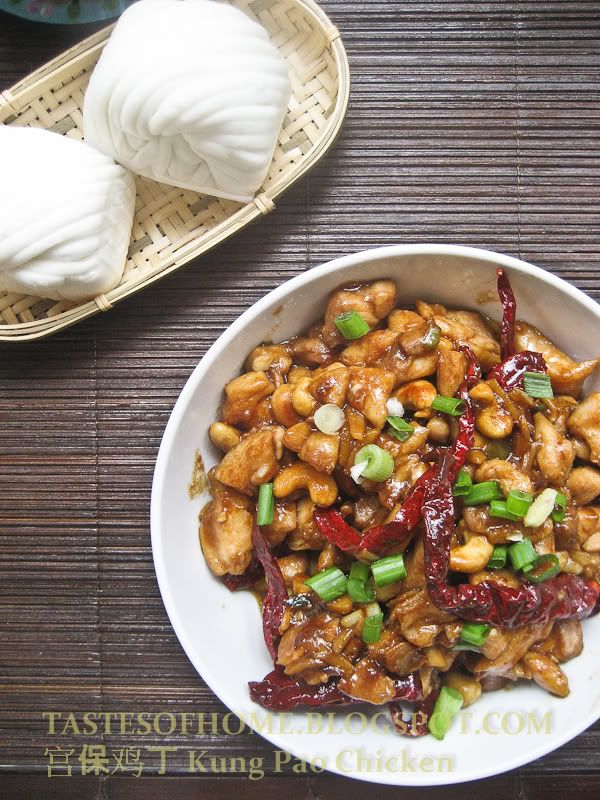
Legend has it that the dish was so named in deference to the inventor of the dish, a Chinese government official 丁宝桢, Deng Baozhen who lived during the Qing Dynasty. Deng was from Gweizhou and had always been very fond of spicy stir-fried chicken cubes and had requested his cook to prepare the now famous dish since his days in Gweizhou. However, the dish only started gaining fame when he moved to Sichuan as the new governor since he always served this spicy dish to guests at his residence. The original version was cooked with peanuts but I prefer to have cashew nuts in my kung pao chicken;which is the version I am featuring today.
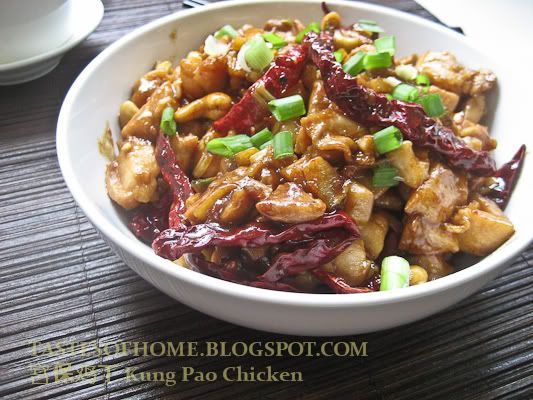
Purists might be miffed though as I omitted Sichuan peppercorns (花椒) a traditional spice used in many Sichuan dishes which creates a unique 'tongue-numbing' (麻辣) sensation - this was because I knew that my guests are not fans of the 麻辣 style of cooking. However, do include the peppercorns if you get a chance for a taste of the original. All in all, I absolutely adore this dish - serve with steamed rice or Chinese steamed flower rolls.

Thursday, November 18, 2010 |
Labels:
Asian Soups,
Korean Food,
Korean Recipes,
tofu recipes
|
12 Comments »
Soondubu jjigae (순두부찌개) is one of the classics in Korean stews - soondubu refers to soft tofu while jjigae means stew. Soondubu jjigae is a spicy stew with seafood and usually beef (but I used chicken) base cooked with extra soft, silky tofu. I have always loved Korean cuisine and only recently started to cook Korean food at home. I love how Koreans use a variety of colouful and nutritious vegetables especially in their stews and soups - and after making maeuntang (spicy fish soup) earlier that I adapted from Maangchi with delectable results, I decided to try making today's popular soondubu jjigae also based on a recipe from Maangchi.
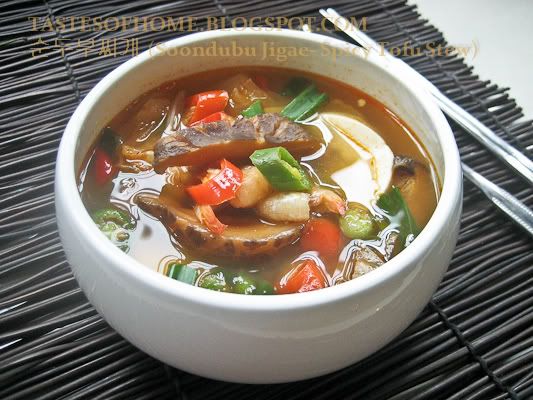
Instead of gochujang (spicy chilli paste) that was used in the maeuntang, Maangchi advocates using gochugaru (spicy chilli powder) instead, although a quick look around the web brought up all kinds of variations where some cooks vouch for the gochujang version and some for gochugaru while some used a mix of both. I am no expert on Korean cuisine but I think the most important thing with food in general is that it suits your own tastebuds and I find it extremely enjoyable to experiment and come up with your own recipes.

I used Chinese cabbage (Nappa) in my soondubu jjigae today but you can substitute with your favourite vegetables - I think spinach will work extremely well. The cabbage and seafood added natural sweetness to the soup while the meaty shitake mushrooms and silky soft tofu added great contrasting textures. All in all, I was extremely satisfied with the results. By the way, the Chinese in me tells me that this stew would make a great base for noodles, especially rice noodles.
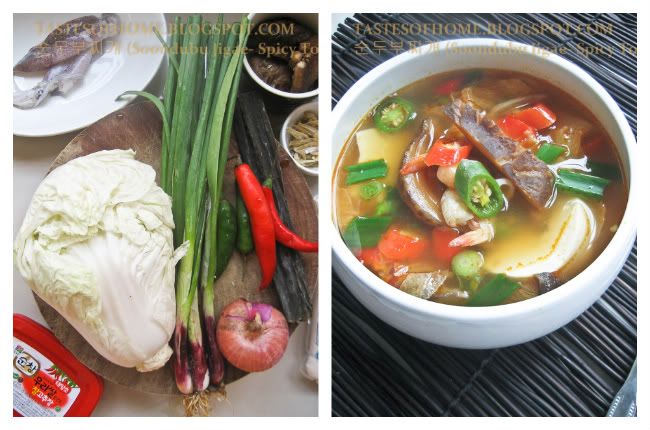

Tuesday, November 16, 2010 |
Labels:
Baking,
Cookies,
Desserts
|
3 Comments »
Cornflake cookies are always seen during festive times in Malaysia especially during the Muslim New Year, Hari Raya. I had a sudden urge to make cornflake cookies as (1) I have yet to try making them, (2) the recipes sound simple enough and of course (3) the ingredients were readily available in my kitchen. I found this easy recipe from Kuali and after reading the encouraging comments I decided to give it a try. These cookies were quite tasty and the crunchy toasted cornflakes added great texture. As the list of ingredients is so short, it is extra important to use good quality butter and eggs. The recipe called for cornflour which added to the crispiness of the cookies, so if you like crispy cookies you will probably like these. I thought these cookies were satisfactory but I am still undecided if I will make these again as maybe I am not as big of a fan of cornflake cookies as I thought I was. I do have a cookie recipe I would make again and again though - my French butter cookies, a recipe I found on Martha Stewart.
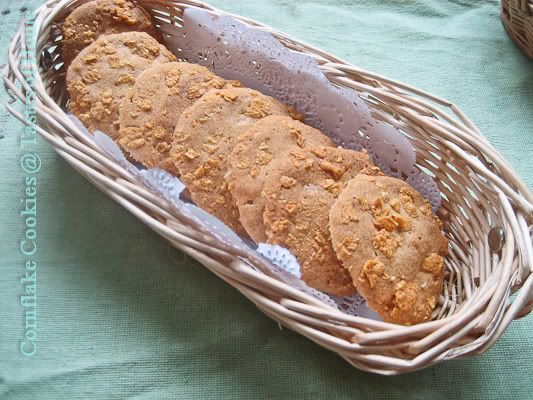
You can also substitute the cornflakes for nuts like toasted hazelnuts or chopped up almonds for a different cookie altogether. I found the first batch to be a little too sweet hence I reduced the amount of sugar in the recipe and also omitted the lemon rind. Cornflake cookies seem to be a Malaysian invention, I have yet to see these cookies sold anywhere in the US or in the UK - or maybe these cookies just caught on in Malaysia?
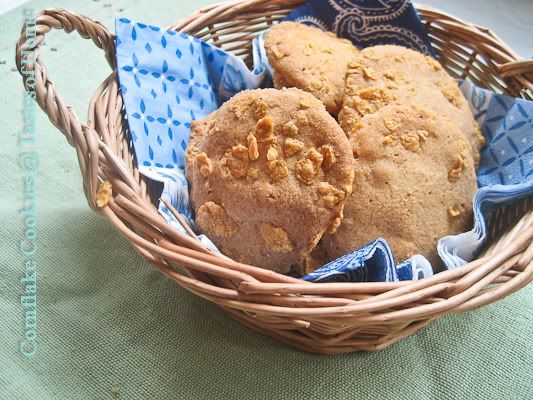
Plusses for these cookies: extremely easy to make and a great way to have cornflakes!

Sunday, November 14, 2010 |
Labels:
Belacan,
Malaysian food,
Malaysian recipes,
Spicy,
Stir-fry
|
9 Comments »
Sambal belacan ikan bilis is definitely a classic in Malaysian cuisine. Sambal belacan essentially refers to a spicy chilli paste that can be added with different ingredients to suit different taste buds but the basics are chilli peppers (of course!) and toasted shrimp paste (belacan). This popular condiment cooked with anchovies for today's feature is extremely versatile and is a great base for many dishes from vegetables like kangkong (water spinach), stuffed in fish and used in fried rice. To the uninitiated however, sambal belacan may be too pungent - this condiment definitely belongs to the 'acquired-taste' category!
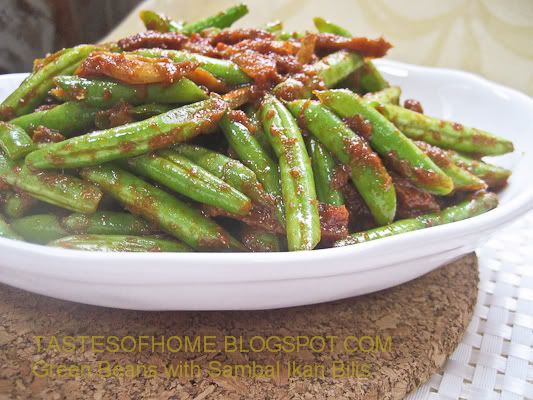
Although I can't say I'm a strict purist when it comes to cooking, but for sambal belacan I prefer to use the mortar and pestle and pound my belacan the old-fashioned way instead of opting for the blender or food processor. It can be time consuming however to pound the belacan the old-fashioned way so maybe that's why I don't cook with belacan a lot. I usually make extra belacan while I'm at it as if you keep the sambal belacan in an airtight container in your fridge, it can keep up to 1 week at least (that is if it will last that long!). Today's feature is a simple and quick stir-fry I will usually whip up whenever I happen to have some homemade belacan sitting in the fridge.
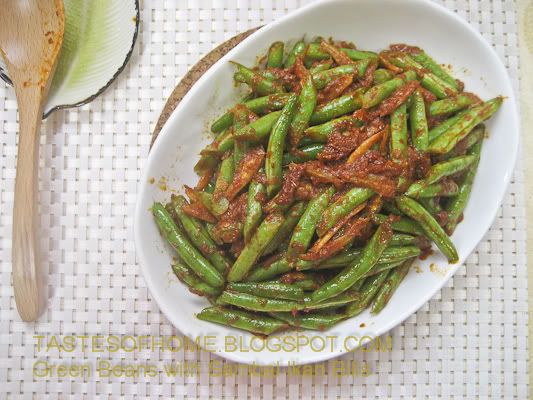

Saturday, November 13, 2010 |
Labels:
asian desserts,
chinese desserts,
Desserts,
malaysian desserts
|
5 Comments »
Sweet green bean soup is an extremely popular Chinese and Malaysian dessert. Today I am featuring the Malaysian Chinese version where candied coconut or gula melaka (Malay) is used to replace regular sugar. Gula Melaka is essentially the sugar from the coconut tree and is added to many popular Malaysian desserts for its' rich aromatic fragrance. Gula Melaka syrup is also used in the popular Chinese tofu dessert, 'tau fu fa' and even serves as a great topping for caramel custard.
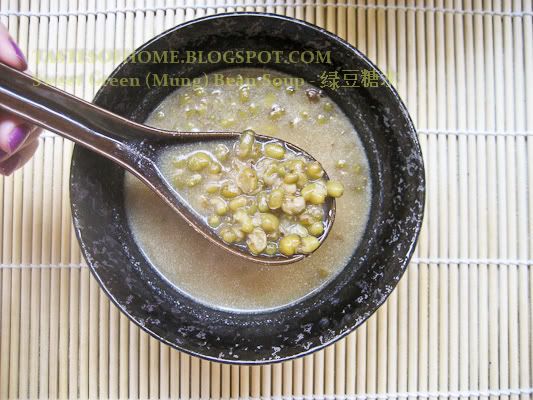
Green or mung bean soup is believed to have heat-relieving (清热) properties so much so that women are usually advised not to consume too much as the Chinese traditionally believe that women who consume too much foods with cooling qualities may find it hard to conceive in future. Hence, green bean sweet soup is probably better to consume during in the summer, but of course in tropical countries, green bean soup is a favourite year-round! Coconut milk or commonly known as santan in Malaysia is added as a final touch - all in all this is a rather indulgent dessert!
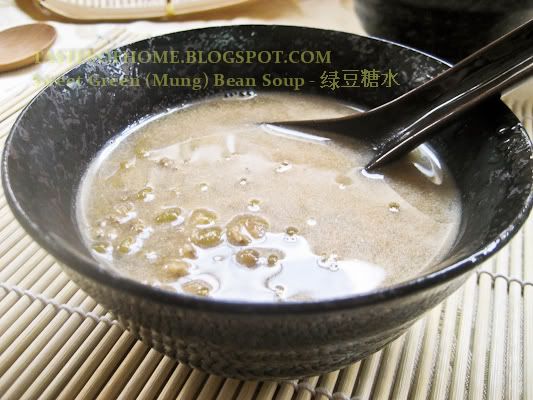
Gula Melaka is sold in logs and is dark brown in colour


Thursday, November 11, 2010 |
Labels:
Chinese food,
Chinese recipes,
Duck,
Noodles,
Poultry recipes,
Quick meals
|
14 Comments »
I love noodles and rice noodles are one of my favourites as I find rice noodles less oily than egg or yellow noodles. Rice noodles are usually sold dried and consists mainly of rice powder/ flour. There are so many delicious ways to cook these noodles - ranging from stir-fried, steamed and of course served in soup or broth. Today's feature was concocted while walking around in the grocery store - I had initially wanted to make potato salad but somehow ended up making rice noodles in soup instead! Even though I love potato salad, I can't eat too much of it probably because I'm not a huge lover of mayonnaise or sour cream.
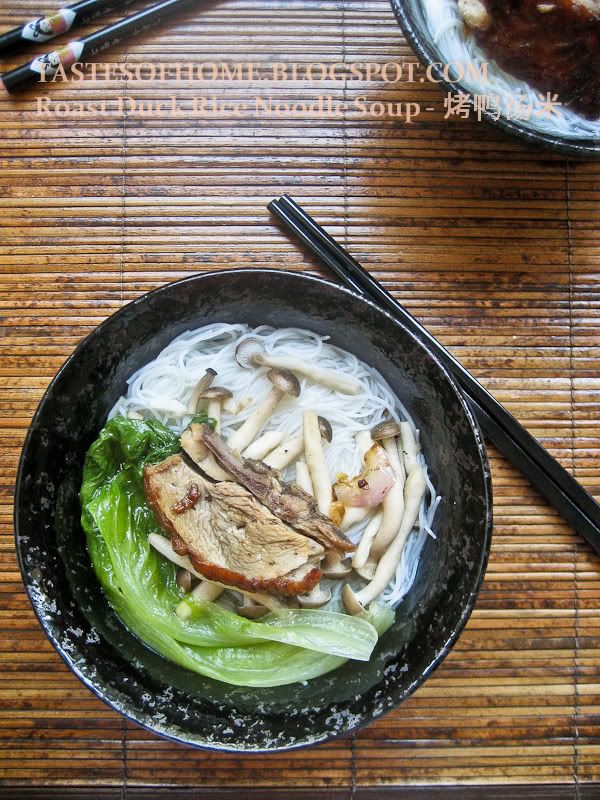
Anyways, today's rice noodles (米粉) or also known as mee hoon/ bihun in Malaysia are simply served in home-made chicken and anchovy broth topped with shimeji mushrooms and roast duck. I used roast duck as we had some leftover from dinner the night before. If you don't have roast duck readily available, just substitute with chicken or shrimp. I tried the noodles without the roast duck as well and they were still very satisfying as the shimeji mushrooms and the lettuce add good texture to the dish.

I am submitting this to Presto Pasta Nights created by Ruth of Once Upon A Feast which is hosted by Helen of Fuss Free Flavours this week. Check out the link if you want to join in the fun!

Monday, November 08, 2010 |
Labels:
Asian Comfort Food,
Asian Soups,
Korean Food,
Korean Recipes
|
14 Comments »
I am a huge fan of soups and I have been wanting to make mauentang, a Korean spicy fish soup for the longest time so I was delighted when I found Maangchi's mauentang recipe. This is a spicy fish soup or rather stew with an abundance of nutritious vegetables which does not require a long boiling time. I think it is customary to use garland chrysanthemum or 'tong hoe' in Chinese in this popular soup, however I substituted it with Nappa cabbage since I couldn't find any 'tong hoe'. I thought the cabbage added just the right amount of natural sweetness to the soup. Grated ginger is used in this soup as well which masked the 'fishiness' really well.
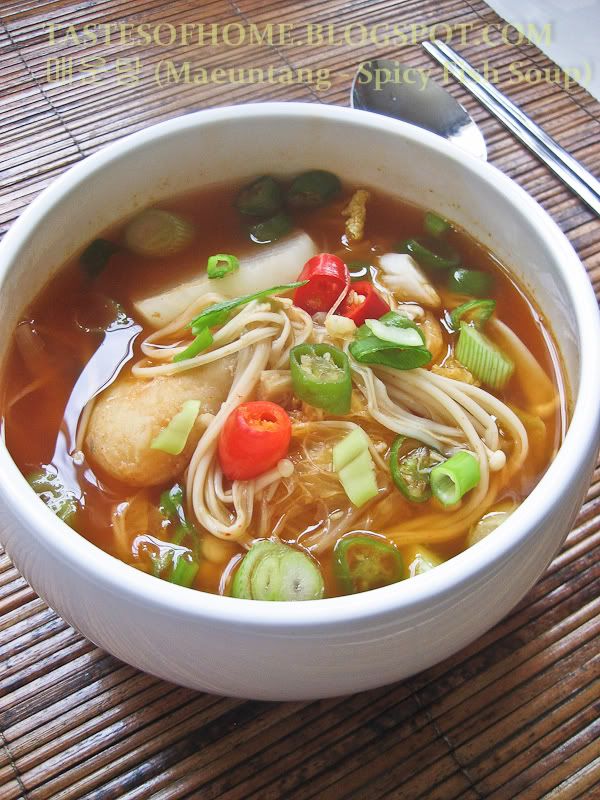
From my limited knowledge of cooking Korean food, it appears that Koreans are fond of adding minced garlic to their soups which works perfectly with the gochujang (Korean chilli paste) used, probably the most-used condiment in Korean cuisine. Gochujang is essentially made of red chilli powder, glutinous rice powder mixed with powdered fermented soybeans and salt. The condiment is rather pungent and is an acquired taste rather like most fermented Asian foods. I love the spiciness and the earthiness (from the fermented soybeans) of the condiment which is rather like heavily spiced up miso. Radish, kelp and shitake mushrooms provide a great base that is then flavoured with the fish, gochujang and the other colourful vegetables.
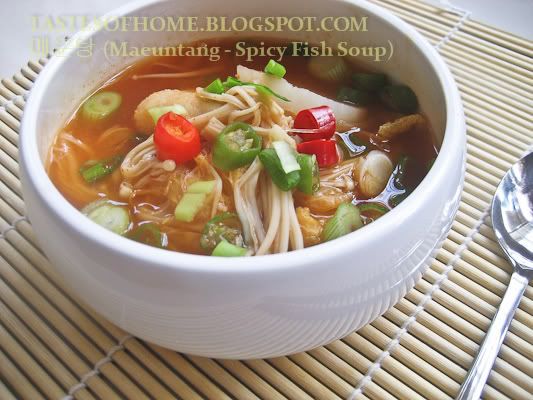
I found this to be a very satisfying soup and is extremely yummy served with rice especially on a cold rainy day. Korean dishes are also always so pretty and colourful, don't you think?

Saturday, November 06, 2010 |
Labels:
Chinese food,
Quick meals,
Shrimp Recipes,
tofu recipes
|
12 Comments »
I love egg tofu or 玉子豆腐 in Chinese which tastes richer than the usual plain tofu. Just like tofu, egg tofu is extremely versatile and tastes great simply steamed or stir-fried lightly like today's feature. Today's stir-fry recipe is another one of mom's tasty recipes - egg tofu slices are first pan-fried lightly then gently stir-fried with shrimp and green onions. Egg tofu is usually sold in tubular form in vacuum packs and you can find these in most Asian grocery stores in the refrigerated section near the regular tofu packs. Usually the tofu is more of a second ingredient in a dish (unless it's a vegetarian dish of course!) but I think the yummy egg tofu was the undisputed star of today's dish!
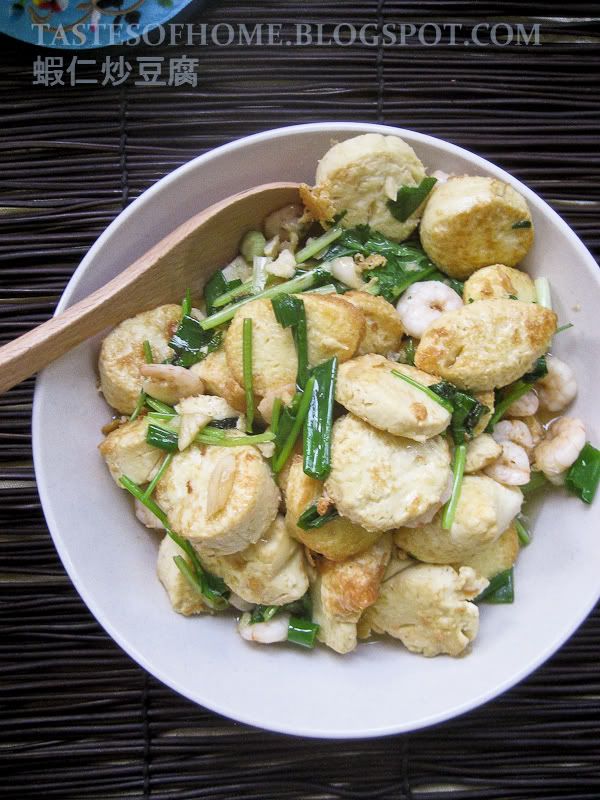
The egg tofu is first pan-fried to ensure it does not break easily while being stir-fried with the shrimp and also for a richer aroma. I really love the simple deliciousness of this dish, you can also just use regular tofu slices if you can't find egg tofu for this dish although I think the egg tofu adds so much more flavour.
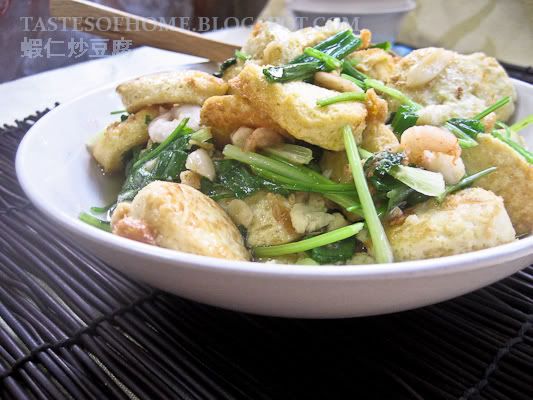
If you prefer a vegetarian dish, simply skip the shrimp!

Thursday, November 04, 2010 |
Labels:
Chinese recipes,
Noodles,
Pasta,
Quick meals,
Vegetarian
|
6 Comments »
Here's an 'unconventional' way of cooking macaroni - this method of cooking macaroni is extremely popular in Asia especially in Hong Kong's famous 'tea cafes' (茶餐厅) which feature a lot of quick and delicious fusion cuisine. Today's macaroni is simply stir-fried with shallots and oyster mushrooms with splashes of soy sauce and sesame oil. This is a great method for using up leftover ingredients as you can see - I had one lone carrot and half a packet of oyster mushrooms sitting in my fridge after cooking my japchae earlier and I thought this would be the perfect method to finish up the ingredients. You can be creative with the ingredients and add whatever you prefer.
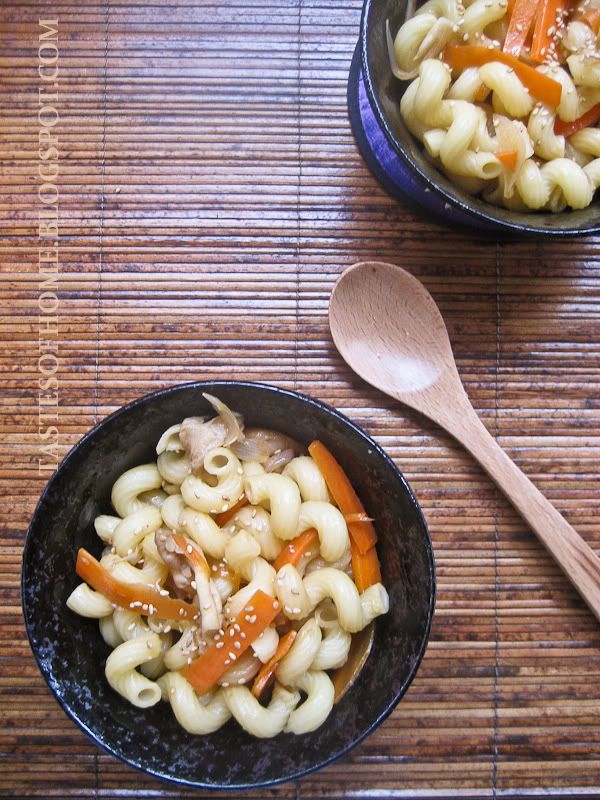
Apart from stir-frying, macaroni is also great cooked in some chicken broth - especially comforting when one is feeling ill as well.
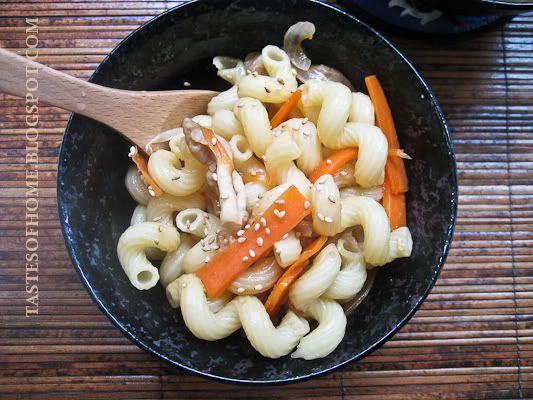
I am submitting this entry to Presto Pasta Nights created by Ruth of Once Upon A Feast. Check out the link for more information on how to join in the fun!



Tuesday, November 02, 2010 |
Labels:
Asian Hors-d'oeuvres,
Asian Snacks,
Korean Food,
Korean Recipes,
Vegetarian
|
13 Comments »
I love pa jeon or 파전 in Hangul which is basically a savoury pancake made with green onions which is an extremely popular Korean snack, banchan (the little side dishes) at meals or as anju (dishes consumed while drinking). These pancakes are especially popular on rainy days and eating these with soju is definitely comforting although I have to admit I'm not much of a drinker. Anyway, these were extremely easy to make consisting of only flour, water, egg and of course the green onions. There are many variations to this basic recipe where you can add seafood, kimchi, mushrooms and the list goes on.
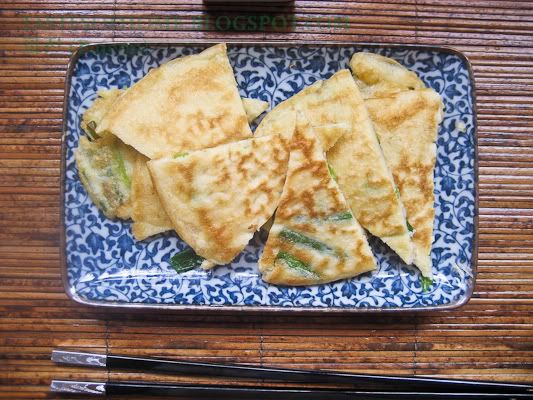
Although similar in many ways to the equally delicious Chinese snack, green onion pancakes (葱油饼) pa jeon is more of a 'true' pancake in that it is made with batter whereas the Chinese version is essentially fried dough.
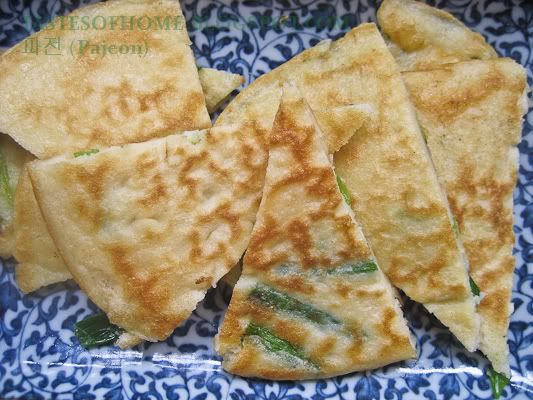
I merely used all-purpose flour with a tiny bit of baking powder today but you can substitute a portion of the flour with rice flour which should make the pancakes fluffier or corn starch which should add to its' crispiness. Anyhow, this is an extremely easy and delicious snack to prepare at home and I can't wait to experiment with more ingredients next time!


No content from this website including images, recipes, writings may be reproduced without prior consent from the author.




 Subscribe to Feed
Subscribe to Feed

































